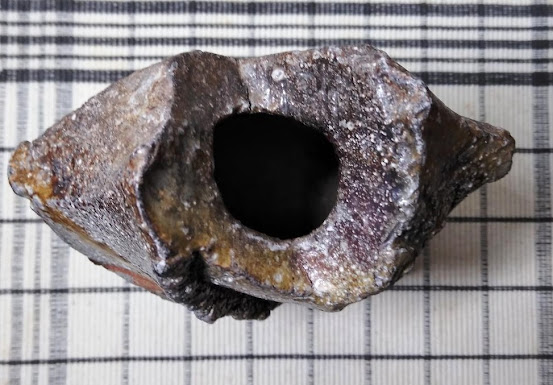222. ATARASHI Manabu 新学, 1973- , Iga shinogi hanaire 伊賀鎬花入 (Iga-ware knife-blade vase)
Atarashi Manabu is the son and successor of Atarashi Kanji. He has been designated a Traditional Craftsman of Iga-ware. Shinogi is the name of the ridge on a Japanese sword and is used in potting to refer to a technique of hand carving that leaves ridges and grooves in the surface, the type of surface that in Western pottery is often called "faceted" or "grooved." This gives the ash a foothold as it blows through the kiln and allows for natural ash glazing to form on the surface. The molten ash flows across the surface, creating patterns as it cools. Here it also seems to refer to the knifeblade-shaped cuts on the front and back sides.
Gray clay, unglazed, with heavy kiln effects on the base and back side coloring the clay black and gray; the front side has reddish scorch marks and gray colors; some ash melt on the sides and the area around the mouth, with one bidoro bead flowing over the shoulder on the left front. Weight: 1.7 kg (3.7 lb). Height: 22.3 cm (8-7/8 in). Width: widest 15.5 x 12.4 cm (6-1/8 x 4-7/8); base 10.3 x 8.3 cm (4-1/8 x 3-1/4 in).
This sits on the flat base, whose shape is a semi-circle toward the right-hand side and two straight lines meeting at an angle in the center of the left-hand side. The artist’s mark—a rough rectangle with a sword-shaped object in the middle—is incised into the base. The widest part of the piece is about a fourth of the way above the base. The front of the piece shows the remnants of the four wads used to separate the piece from the shelf in the kiln. The center of the front is a deep blade-shaped groove extending from about 3 cm (1-1/4 in) above the base to the V-shaped notch at the top. The right-hand side merges into the back, which generally mirrors the shape of the front. The back has wedges of clay topped with a flat shelf on both sides near the base—the points of these shelves form the widest dimension of the piece. Above the shelves, both sides of the piece are concave arcs rising to the shoulders. There is another deep blade-shaped groove slanting to the left and extending from just above the base to the top of the piece. The left-hand side is triangular, extending from 2.5 cm (1 in) above the base to the shoulder. The shoulders are 17.7 cm (7 in) above the base on both sides. The back and front meet in a ridge that curves upward from the shoulders in a concave arc to the highest points on both sides of the mouth. The V-shaped notch begins in the center of both the front and back at 18.5 cm (7-3/8 in) above the base and rises at a sharp angle in straight lines to the highest points. The edges of the rim surrounding the mouth are 2.5 cm (1 in) wide. The mouth is just slightly above the bottom of the V-shaped notch and is around 3 cm (1-1/4 in) wide. The interior of the piece mirrors the general shape of the exterior, without the grooves and protrusions. The surface is rough.
This was unglazed and wood-fired in an anagama kiln. To judge from the wad marks and the kiln effects, this was fired with the front side down and the base toward the flames. The base and the back side are gray and black in color, with a heavy ash deposit on the back. The front shows red and lighter gray colors. There are only minor kiln effects on the interior. A melted ash glaze covers the bottom and the left-hand side, the edges of the notch surrounding the mouth, and (to a lesser extent) the front. There is a single bidoro tear coming over the left-hand shoulder to the front.
This came with a box inscribed in three lines: 伊賀 (Iga); 鎬花入 (shinogi hanaire, shinobi vase), and 新学, the artist’s name, with his seal stamped in red. Included inside the box were a wrapping cloth, stamped with the artist’s seal, and two leaflets, one in English, the other in Japanese, with a potted biography of the artist.
Purchased from Kura Monzen in Kyoto, Japan, June 2023 (invoice, shipping and customs documents).












No comments:
Post a Comment